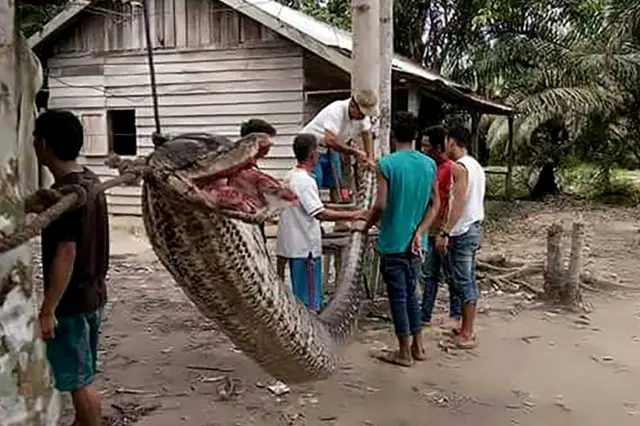TQ. When they sliced open the 8-meter python, no one expected to find what the world now can’t stop talking about — an entire man swallowed whole.

In a small village tucked away in Indonesia’s dense, humid jungles, a horror story has unfolded that reads more like folklore than news. Local authorities discovered an 8-meter-long reticulated python whose bloated body concealed a grim truth: inside it, the remains of a man. The shocking revelation has sent ripples across the globe, igniting debates, fears, and questions about the perilous intersection between humans and nature. Beyond the immediate horror lies a complex tapestry of ecological dynamics, human vulnerability, and cultural reckoning.
Discover more
Privacy policy template
Lionel Messi jerseys
News subscription box
Disclaimer template
Princess Diana memorial items
Spanish language courses
Puppy care products
Space exploration news
Paul Walker tribute items
Disaster preparedness kits
The Discovery: From Routine to Nightmare
The man, a 25-year-old local farmer, had ventured into the nearby forest early in the morning, carrying only basic tools for tending crops and foraging. Known in the village for his familiarity with the dense forest terrain, his sudden disappearance raised alarms. Villagers recount the anxiety that mounted as hours passed without a sign of him, culminating in a frantic search that eventually led them to the python — a colossal serpent so massive that it seemed almost mythical.
Discover more
Paul Walker tribute items
Emergency response training
Terms of service
Luxury travel experiences
Current events podcast
WordPress development service
Space exploration documentaries
Royal family biographies
Fast & Furious movie collection
Dog

Upon examination, authorities confirmed the unthinkable: the man had been consumed whole. The scale of the snake, the method of its predation, and the swiftness of the attack collectively left even experienced locals stunned. The discovery sparked immediate grief and outrage, but it also ignited a wave of curiosity. How could such an encounter happen? What sequence of events led to the man’s fatal confrontation with this apex predator?
Understanding the Reticulated Python: Nature’s Silent Killer
Discover more
Royal family biographies
News subscription box
Fast & Furious movie collection
Astronomy equipment
Space exploration documentaries
dog’s
Puppy care products
Romantic anniversary gifts
Comet tracking software
Manchester City fan gear
Reticulated pythons (Python reticulatus) are among the largest snakes on the planet, capable of reaching lengths over 8 meters and weights exceeding 150 kilograms. Unlike venomous snakes, they do not rely on poison but on sheer strength. They constrict their prey, coiling their muscular bodies until the victim suffocates before swallowing it whole.
Dr. Andi Wirawan, a herpetologist specializing in Southeast Asian reptiles, emphasizes their stealth and predatory precision: “These snakes are ambush predators. They can wait motionless for hours, blending into their environment. When they strike, it is sudden and often lethal. While humans are not typical prey, unfortunate encounters can be fatal due to the snake’s size and power.”
Discover more
Aviation safety courses
Urgent news app
dog’s
Disaster preparedness kits
UFO documentary
Privacy policy template
Space telescope viewing
Manchester City fan gear
Real time updates
Alien invasion fiction books
Experts note that the speed and surprise of such attacks leave minimal opportunity for escape. In regions like Indonesia, where humans live adjacent to the natural habitats of large predators, the risk, though statistically rare, is ever-present.
The Sequence of Events: Piecing Together the Tragedy
Eyewitnesses and local villagers have provided fragmented yet haunting accounts of the morning of the incident. The man reportedly entered the forest alone, following familiar paths. According to neighbors, the weather was clear, and the man was in good spirits — making the tragedy all the more bewildering.

Locals later reported hearing unusual rustling in areas where the snake was later found. One witness described seeing a “shadow moving unnaturally fast among the trees,” which, in retrospect, may have been the python in its deadly approach. Villagers familiar with snake behavior initially dismissed the odd sighting, but the combination of the man’s disappearance and the presence of an unusually large serpent soon clarified the horror that had occurred.
Authorities meticulously documented the discovery, both for legal purposes and to understand the ecological factors at play. Photographs and measurements confirmed that the python had consumed the man whole, leaving little evidence of struggle, a testament to the efficiency and lethality of the predator.
Human Vulnerability and Psychological Dimensions
While the physical facts of the incident are shocking, the psychological dimensions are equally profound. In close-knit rural communities, the sudden loss of a young, healthy adult to a wild predator reverberates far beyond immediate grief. Psychologists warn of potential long-term effects: heightened anxiety, trauma related to forested areas, and collective fear that alters daily routines. For villagers who rely on the forest for their livelihoods, this incident introduces a chilling paradox — the very environment that sustains them can also be lethal.
Moreover, the global fascination with such incidents reflects a deeper human fear of being vulnerable to forces beyond our control. In a world dominated by technology and urban life, the idea that a human can be overpowered by a natural predator reminds us of our fragile position within the natural order.
Ecological Context: Why These Encounters Occur
Southeast Asia is home to some of the largest snakes in the world, and Indonesia, with its dense forests, rivers, and wetlands, provides an ideal habitat. Human encroachment into these areas, for agriculture, logging, or settlement, increases the likelihood of encounters with apex predators.
While fatal attacks are rare, they are not unheard of. Historical records over the past two decades document several cases of reticulated pythons preying on humans in Indonesia, often involving individuals in remote or rural areas. Experts emphasize that the snakes are not inherently aggressive toward humans but act according to instinct when presented with a prey opportunity that meets their size criteria.

This incident highlights the delicate balance required when humans and wildlife coexist. Conservationists stress the importance of education and preventive measures, such as:
- Understanding snake behavior and habitats.
- Avoiding forested areas during peak activity times for large predators.
- Implementing community monitoring and early warning systems for dangerous wildlife.
Cultural and Social Repercussions
In addition to ecological and psychological factors, cultural responses are significant. In many Indonesian communities, snakes are imbued with symbolic meaning — representing both danger and spiritual power. The tragedy has sparked discussions about rituals, taboos, and traditional methods of coexistence with snakes, as villagers attempt to reconcile grief with cultural understanding.
Internationally, social media amplified the horror, with reactions ranging from shock and disbelief to analytical debates on wildlife safety. Scientists, journalists, and public safety advocates have weighed in, calling for a measured response that balances conservation with human safety.
Lessons and Warnings: A Broader Perspective
Beyond the immediate tragedy, this incident serves as a stark reminder of the broader challenges in human-wildlife interactions. As rural populations expand, the likelihood of encounters with apex predators increases, highlighting the need for both awareness and respect for natural boundaries.
Experts emphasize that coexistence is possible, but it requires:
- Education: Teaching villagers, farmers, and tourists about local wildlife and avoidance strategies.
- Safety Infrastructure: Community patrols, motion detection systems, and early warning mechanisms in high-risk areas.
- Research: Tracking predator movements to anticipate potential conflict zones and inform policy decisions.
Ultimately, the goal is to prevent future tragedies while maintaining the ecological balance that allows both humans and wildlife to thrive.
A Haunting Reminder of Nature’s Power
The story of the Indonesian man and the 8-meter python is both terrifying and sobering. It forces a confrontation with uncomfortable truths: humans, despite technological prowess and intelligence, are still vulnerable to nature’s primal forces. The incident illustrates the lethal efficiency of apex predators and the unpredictable outcomes when human curiosity, livelihood, and survival intersect with the wild.

As authorities continue investigations and global audiences digest the details, one haunting question remains: how can humans coexist safely with creatures capable of such power? In the absence of a perfect solution, the tragedy serves as a cautionary tale — a reminder of respect, vigilance, and humility before the natural world.
Conclusion: Beyond Shock, Toward Understanding
While the immediate shock of the incident is visceral, the deeper implications extend into ecology, psychology, and culture. It is a story of nature asserting its dominance, human vulnerability exposed, and communities grappling with both grief and the need for action.
The discovery of a man inside a colossal python is more than a sensational headline — it is a call to reflect, prepare, and understand. As humanity continues to expand into wild spaces, incidents like this may remain rare but will remain stark reminders that the natural world, in all its majesty and terror, deserves our respect.
The world watches, horrified and introspective, as a small village in Indonesia confronts a tragedy that is both local and universal — a chilling tale of survival, mortality, and the power of nature that refuses to be tamed.



